Analysis of Land Use/Cover Change and Driving Forces in the Selenga River Basin
Abstract
:1. Introduction
2. Case Area Overview and Method
2.1. Overview of the Study Area
2.2. Methods and Data
2.2.1. Data
2.2.2. Methods
- Unifying the land use/cover classification of the Selenga River basin
- 2.
- ANUSPLIN interpolation
- 3.
- Logistic regression model construction
- (1)
- Create a land-use change layer
- (2)
- Establish driving factor layers
- (3)
- Random sampling and extraction of variable values
- (4)
- CA-Markov model construction
- (1)
- Cell composition
- (2)
- Make 2000–2009 (verification of prediction accuracy), 2009–2015 of each land type transfer area matrix and conditional probability matrix.
- (3)
- Creating an atlas of land transfer suitability
- (4)
- Land use simulation and prediction
3. Results and Analysis
3.1. Land Use/Cover Pattern and Change
3.2. Changes and Distribution of Major Land Types
3.3. Analysis of Driving Factors of Major Land-Type Changes
3.4. Land Use/Cover Simulation and Prediction Analysis
4. Discussion
5. Conclusions
- From 1992 to 2015, the land-use types of the basin were mainly forest and grassland, plots of the land use/cover change were mainly distributed in the central and western regions of the research region, and the area of change accounted for 38.23% of the total area of the research region. The land use/cover change had obvious spatial differences, and the land-use transfer in the regions along the traffic lines was relatively severe. The area of construction land decreased slightly from 1992 to 2000, and maintained a generally stable trend from 2000 to 2015. The area of croplands increased from 1992 to 2000 and showed a decreasing trend from 2000 to 2015. The area of forest decreased during the study period, while the area of bare land and grassland kept increasing. The area of water/wetlands is basically unchanged.
- Mathematical models were used to quantitatively and comprehensively characterize the effects of natural and social factors on land use changes. It was found that the transformation of each land use type in the Selenge River Basin over 23 years was closely related to the changes in local temperature and precipitation over the years, while indirect factors generated by human activities also had some influence. With the rising level of urbanization within Mongolia, the farming and herding population has been decreasing, leading to a decrease in arable land area. Other drivers of arable land shrinkage are climatic factors such as decreasing precipitation, which have a significant impact on farmers’ decisions on crop selection and development areas, and climatic disasters caused by climate change, which have a serious impact on crop harvesting and arable land reclamation. In addition, cropland shrinkage is preferred in higher altitude areas, but with the deepening of human activities and global climate change, these areas are also gradually used for cropland development, thus the probability of shrinkage decreases to a certain extent; due to the cold and drought tolerant growth characteristics of coniferous forests, area expansion is more likely to occur in areas with reduced precipitation, higher temperature, and higher altitude, while less human intervention also has a certain impact; in areas with abundant precipitation and lower temperature In the early stage, the closer the distance from rivers, the more likely the expansion of grassland will occur, while in the later stage of the study, the farther the distance from water systems and traffic arteries, the more likely the expansion of grassland in areas with inactive human activities.
- The CA-Markov model was used to predict the land use/cover pattern of Selenge River Basin in 2027. From the change in the number of land types, it was found that the area of construction land expanded slightly, the area of forest land remained stable, and the area of grassland decreased. In terms of spatial distribution, the area of construction land around the cities in both countries increases slightly, the area of cultivated land increases somewhat in the middle reaches of the basin, but tends to shrink in the southwest side of Mongolia and the south side of Russia, the area of forest land expands in the northeast side, and the area of grassland expands significantly in the upper and middle reaches of the basin. There is a certain expansion of water area in the delta area of Selenge River.
Author Contributions
Funding
Data Availability Statement
Conflicts of Interest
Appendix A
| Variable | 1992–2000 | 2000–2009 | 2009–2015 | ||||||
|---|---|---|---|---|---|---|---|---|---|
| Regression Coefficient β | Wald | EXP (β) | Regression Coefficient β | Wald | EXP (β) | Regression Coefficientβ | Wald | EXP (β) | |
| Altitude | −0.412 | 29.707 | 0.662 | −0.199 | 7.261 | 0.819 | 0.351 | 4.676 | 1.421 |
| Slope 1 | −2.365 | 0.000 | 0.000 | −2.713 | 0.000 | 0.000 | −2.039 | 0.000 | 0.000 |
| Slope 2 | −0.537 | 1.037 | 0.584 | −0.252 | 0.454 | 0.777 | −0.299 | 0.417 | 0.742 |
| Slope 3 | −0.199 | 0.144 | 0.820 | 0.067 | 0.026 | 1.070 | 0.162 | 0.131 | 1.176 |
| Slope 4 | 0.146 | 0.076 | 1.157 | 0.177 | 0.177 | 1.193 | 0.128 | 0.081 | 1.136 |
| Slope 5 | 0.420 | 0.549 | 1.521 | 0.281 | 0.406 | 1.324 | −0.236 | 0.245 | 0.790 |
| North slope | −0.958 | 2.191 | 0.384 | 0.019 | 0.016 | 1.020 | 0.132 | 0.580 | 1.142 |
| Northeast slope | 0.009 | 0.002 | 1.009 | −0.048 | 0.086 | 0.953 | 0.171 | 0.861 | 1.186 |
| East slope | −0.006 | 0.001 | 0.994 | −0.227 | 2.190 | 0.797 | 0.275 | 2.432 | 1.317 |
| Southeast Slope | 0.265 | 2.154 | 1.303 | 0.032 | 0.036 | 1.033 | 0.089 | 0.171 | 1.093 |
| South slope | −0.076 | 0.212 | 0.927 | −0.008 | 0.002 | 0.992 | 0.184 | 0.668 | 1.202 |
| Southwest slope | −0.150 | 0.910 | 0.861 | −0.140 | 0.771 | 0.870 | 0.106 | 0.253 | 1.112 |
| West slope | −0.253 | 2.396 | 0.776 | −0.074 | 0.214 | 0.928 | −0.167 | 0.668 | 0.846 |
| Northwest slope | 0.021 | 0.013 | 1.021 | −0.026 | 0.023 | 0.975 | 0.254 | 1.769 | 1.289 |
| Distance to river | 0.187 | 25.593 | 1.205 | 0.036 | 0.903 | 1.037 | −0.057 | 1.428 | 0.944 |
| Distance to road | 0.112 | 8.096 | 1.118 | −0.115 | 8.405 | 1.121 | 0.059 | 1.576 | 1.061 |
| Distance to railway | 0.152 | 4.631 | 1.164 | 0.061 | 0.560 | 1.063 | 0.302 | 13.786 | 0.739 |
| Average annual temperature | −0.695 | 117.658 | 0.499 | −0.221 | 7.264 | 0.802 | −0.125 | 0.374 | 0.121 |
| Annual precipitation | 0.397 | 50.513 | 1.488 | 0.180 | 7.632 | 0.835 | 0.235 | 7.513 | 1.265 |
| Population density | 0.056 | 2.371 | 1.058 | 0.071 | 2.900 | 1.073 | 0.017 | 3.141 | 1.017 |
| Constant | 1.599 | 8.850 | 4.949 | 0.373 | 0.778 | 1.452 | −0.891 | 3.742 | 0.410 |
| Variable | 1992–2000 | 2000–2009 | 2009–2015 | ||||||
|---|---|---|---|---|---|---|---|---|---|
| Regression Coefficient β | Wald | EXP (β) | Regression Coefficient β | Wald | EXP (β) | Regression Coefficient β | Wald | EXP (β) | |
| Altitude | 0.218 | 9.459 | 0.804 | −0.041 | 6.462 | 1.042 | 0.206 | 6.469 | 1.228 |
| Slope 1 | 0.429 | 0.824 | 0.653 | −2.027 | 0.000 | 0.000 | 1.461 | 0.966 | 4.309 |
| Slope 2 | 0.831 | 1.028 | 0.795 | 0.815 | 3.856 | 2.259 | 0.905 | 4.926 | 2.471 |
| Slope 3 | 0.827 | 1.015 | 0.787 | 0.811 | 3.883 | 2.250 | 0.351 | 0.772 | 1.421 |
| Slope 4 | 0.573 | 0.922 | 0.273 | 0.559 | 1.826 | 1.750 | −0.236 | 0.344 | 0.790 |
| Slope 5 | 0.327 | 0.564 | 0.386 | 0.310 | 0.507 | 1.363 | −0.349 | 0.682 | 0.706 |
| North slope | −2.129 | 3.744 | 0.119 | 0.877 | 1.225 | 2.403 | 0.584 | 0.397 | 1.792 |
| Northeast slope | −0.153 | 0.485 | 0.858 | 0.277 | 3.182 | 1.319 | 0.125 | 0.595 | 1.134 |
| East slope | −0.050 | 0.062 | 0.951 | 0.365 | 6.437 | 1.441 | 0.356 | 5.367 | 1.428 |
| Southeast Slope | −0.082 | 0.138 | 0.922 | 0.631 | 16.047 | 1.879 | 0.648 | 13.874 | 1.913 |
| South slope | −0.174 | 0.752 | 0.840 | 0.889 | 34.726 | 2.433 | 1.150 | 42.769 | 3.158 |
| Southwest slope | −0.215 | 1.288 | 0.806 | 1.054 | 54.336 | 2.869 | 1.167 | 50.140 | 3.212 |
| West slope | −0.214 | 1.180 | 0.808 | 0.744 | 25.629 | 2.104 | 0.693 | 18.527 | 2.000 |
| Northwest slope | −0.033 | 0.024 | 0.967 | 0.432 | 7.467 | 1.541 | 0.262 | 2.417 | 1.299 |
| Distance to river | 0.079 | 3.163 | 1.082 | 0.090 | 7.272 | 0.914 | 0.002 | 0.004 | 1.002 |
| Distance to road | −0.130 | 8.822 | 0.878 | −0.042 | 1.575 | 0.959 | −0.086 | 4.890 | 0.918 |
| Distance to railway | −0.195 | 6.621 | 0.823 | −0.026 | 0.188 | 0.974 | 0.320 | 18.700 | 1.377 |
| Average annual temperature | −0.112 | 13.318 | 0.894 | 0.363 | 1.024 | 0.054 | 0.616 | 4.117 | 0.540 |
| Annual precipitation | −0.245 | 18.764 | 0.783 | −0.042 | 0.707 | 1.043 | 0.309 | 15.473 | 1.362 |
| Population density | −0.010 | 0.055 | 0.990 | −0.009 | 0.075 | 0.991 | 0.145 | 12.305 | 1.156 |
| Constant | −0.092 | 4.466 | 0.912 | −0.250 | 0.351 | 0.779 | −0.727 | 3.206 | 0.483 |
| Variable | 1992–2000 | 2000–2009 | 2009–2015 | ||||||
|---|---|---|---|---|---|---|---|---|---|
| Regression Coefficient β | Wald | EXP (β) | Regression Coefficient β | Wald | EXP (β) | Regression Coefficient β | Wald | EXP (β) | |
| Altitude | −0.004 | 0.008 | 0.996 | 0.338 | 5.531 | 0.713 | 0.702 | 17.710 | 2.018 |
| Slope 1 | −2.193 | 0.000 | 0.000 | −2.844 | 0.000 | 0.000 | −1.918 | 0.000 | 0.000 |
| Slope 2 | 0.864 | 9.470 | 2.373 | 0.825 | 2.702 | 2.281 | 0.627 | 2.961 | 1.872 |
| Slope 3 | 0.368 | 1.822 | 1.445 | 0.694 | 1.950 | 2.002 | −0.044 | 0.015 | 0.957 |
| Slope 4 | 0.250 | 0.833 | 1.284 | 0.490 | 0.968 | 1.633 | 0.036 | 0.010 | 1.037 |
| Slope 5 | 0.277 | 0.938 | 1.319 | 0.355 | 0.474 | 1.426 | 0.056 | 0.023 | 1.058 |
| North slope | −0.138 | 1.399 | 0.871 | −0.102 | 0.532 | 0.903 | −0.012 | 0.007 | 0.988 |
| Northeast slope | 0.008 | 0.005 | 1.008 | −0.011 | 0.005 | 0.989 | 0.035 | 0.053 | 1.035 |
| East slope | −0.128 | 1.188 | 0.880 | −0.254 | 2.926 | 0.775 | 0.180 | 1.510 | 1.197 |
| Southeast Slope | −0.104 | 0.624 | 0.901 | 0.014 | 0.007 | 1.014 | 0.176 | 1.150 | 1.192 |
| South slope | −0.127 | 1.058 | 0.881 | 0.224 | 2.318 | 1.252 | 0.228 | 2.164 | 1.256 |
| Southwest slope | −0.075 | 0.447 | 0.928 | −0.201 | 2.120 | 0.818 | 0.256 | 3.265 | 1.292 |
| West slope | −0.153 | 1.605 | 0.858 | −0.095 | 0.408 | 0.910 | 0.092 | 0.373 | 1.097 |
| Northwest slope | 0.087 | 0.455 | 1.091 | −0.130 | 0.689 | 0.878 | 0.089 | 0.319 | 1.093 |
| Distance to river | −0.118 | 8.191 | 0.889 | 0.075 | 5.118 | 1.078 | −0.248 | 47.377 | 0.780 |
| Distance to road | −0.312 | 2.301 | 0.732 | 0.184 | 23.729 | 0.832 | 0.333 | 80.515 | 0.717 |
| Distance to railway | 0.286 | 7.519 | 1.331 | −0.088 | 4.226 | 0.915 | 0.501 | 82.937 | 1.651 |
| Average annual temperature | −0.085 | 10.510 | 0.918 | 0.056 | 1.085 | 0.491 | −0.743 | 3.259 | 0.223 |
| Annual precipitation | 0.110 | 14.875 | 1.117 | 0.259 | 44.788 | 1.296 | 0.875 | 94.958 | 2.399 |
| Population density | −0.225 | 6.585 | 1.252 | −0.087 | 1.563 | 0.917 | −0.128 | 9.486 | 1.137 |
| Constant | −0.150 | 0.280 | 0.861 | −1.467 | 8.470 | 0.231 | −1.566 | 18.122 | 0.209 |
| Variable | 1992–2000 | 2000–2009 | 2009–2015 | ||||||
|---|---|---|---|---|---|---|---|---|---|
| Regression Coefficient β | Wald | EXP (β) | Regression Coefficient β | Wald | EXP (β) | Regression Coefficient β | Wald | EXP (β) | |
| Altitude | −0.336 | 41.240 | 0.715 | −0.896 | 47.379 | 2.449 | −0.074 | 0.716 | 0.928 |
| Slope 1 | −2.494 | 0.000 | 0.000 | −9.039 | 0.000 | 0.000 | −2.228 | 0.000 | 0.000 |
| Slope 2 | 0.465 | 1.180 | 1.592 | 0.774 | 5.789 | 2.169 | −1.033 | 9.526 | 0.356 |
| Slope 3 | 0.383 | 0.835 | 1.467 | 0.215 | 0.474 | 1.240 | −1.275 | 5.134 | 0.280 |
| Slope 4 | 0.091 | 0.047 | 1.096 | 0.095 | 0.092 | 1.100 | −1.656 | 14.662 | 0.191 |
| Slope 5 | 0.001 | 0.000 | 1.001 | 0.089 | 0.075 | 1.093 | −1.318 | 7.746 | 0.268 |
| North slope | −0.109 | 0.461 | 0.896 | −0.272 | 3.749 | 0.762 | 0.758 | 0.444 | 2.133 |
| Northeast slope | 0.066 | 0.152 | 1.068 | −0.103 | 0.473 | 0.903 | 0.204 | 0.460 | 1.227 |
| East slope | −0.022 | 0.019 | 0.978 | 0.273 | 3.832 | 1.314 | 0.058 | 0.035 | 1.059 |
| Southeast Slope | 0.224 | 1.651 | 1.251 | 0.298 | 3.681 | 1.347 | 0.124 | 0.135 | 1.132 |
| South slope | 0.389 | 5.828 | 1.475 | 0.374 | 6.574 | 1.454 | 0.931 | 11.179 | 2.537 |
| Southwest slope | 0.039 | 0.065 | 1.040 | 0.473 | 12.490 | 1.605 | 0.502 | 3.357 | 1.651 |
| West slope | −0.028 | 0.029 | 0.973 | 0.176 | 1.502 | 1.192 | 0.132 | 0.182 | 1.141 |
| Northwest slope | 0.091 | 0.263 | 1.095 | −0.006 | 0.002 | 0.994 | 0.000 | 0.000 | 1.000 |
| Distance to river | −0.014 | 0.153 | 0.986 | −0.251 | 17.190 | 0.778 | 0.027 | 0.192 | 1.028 |
| Distance to road | −0.246 | 12.976 | 0.782 | −0.356 | 31.019 | 0.701 | 0.003 | 0.002 | 1.003 |
| Distance to railway | 0.160 | 10.986 | 1.173 | −1.133 | 61.395 | 3.105 | −0.320 | 20.958 | 1.378 |
| Average annual temperature | 0.351 | 67.830 | 1.420 | 0.673 | 7.142 | 0.548 | 0.578 | 5.132 | 0.367 |
| Annual precipitation | −0.137 | 38.097 | 0.872 | −1.230 | 63.412 | 3.423 | −0.319 | 19.754 | 1.375 |
| Population density | −0.022 | 0.225 | 0.978 | 0.168 | 9.541 | 1.183 | −0.094 | 6.052 | 0.910 |
| Constant | −1.241 | 8.242 | 0.289 | −0.568 | 3.035 | 0.566 | −1.796 | 14.883 | 0.166 |
| Variable | 1992–2000 | 2000–2009 | 2009–2015 | ||||||
|---|---|---|---|---|---|---|---|---|---|
| Regression Coefficient β | Wald | EXP (β) | Regression Coefficient β | Wald | EXP (β) | Regression Coefficient β | Wald | EXP (β) | |
| Altitude | 0.002 | 0.000 | 1.002 | −0.180 | 20.207 | 0.835 | −0.107 | 7.036 | 0.899 |
| Slope 1 | −1.712 | 0.000 | 0.000 | −2.942 | 0.000 | 0.000 | −2.876 | 0.000 | 0.000 |
| Slope 2 | −0.342 | 1.152 | 0.710 | −1.335 | 9.604 | 0.263 | −0.999 | 15.048 | 0.368 |
| Slope 3 | −0.041 | 0.017 | 0.960 | −0.785 | 3.336 | 0.456 | −0.776 | 9.281 | 0.460 |
| Slope 4 | 0.407 | 1.627 | 1.502 | −0.280 | 0.421 | 0.755 | −0.554 | 4.616 | 0.575 |
| Slope 5 | 0.373 | 1.200 | 1.452 | −0.303 | 0.460 | 0.738 | −0.609 | 4.987 | 0.544 |
| North slope | 0.048 | 0.005 | 1.049 | 0.920 | 1.479 | 2.508 | 0.558 | 0.963 | 1.748 |
| Northeast slope | 0.056 | 0.164 | 1.058 | −0.136 | 1.011 | 0.873 | −0.052 | 0.172 | 0.949 |
| East slope | 0.034 | 0.070 | 1.034 | −0.168 | 1.850 | 0.845 | −0.098 | 0.733 | 0.907 |
| Southeast Slope | −0.116 | 0.709 | 0.890 | −0.061 | 0.219 | 0.941 | −0.229 | 3.643 | 0.795 |
| South slope | −0.195 | 2.281 | 0.823 | −0.115 | 0.885 | 0.892 | −0.266 | 5.603 | 0.766 |
| Southwest slope | −0.196 | 2.536 | 0.822 | −0.152 | 1.713 | 0.859 | −0.355 | 10.903 | 0.701 |
| West slope | −0.102 | 0.621 | 0.903 | −0.141 | 1.316 | 0.869 | −0.351 | 9.490 | 0.704 |
| Northwest slope | 0.073 | 0.283 | 1.076 | −0.164 | 1.518 | 0.849 | −0.152 | 1.467 | 0.859 |
| Distance to river | −0.115 | 17.344 | 0.891 | −0.015 | 0.372 | 0.985 | 0.012 | 0.247 | 1.012 |
| Distance to road | 0.187 | 4.387 | 1.206 | 0.300 | 105.379 | 1.350 | 0.135 | 33.161 | 1.145 |
| Distance to railway | −0.112 | 4.461 | 0.894 | 0.577 | 175.612 | 0.562 | 0.055 | 2.028 | 0.946 |
| Average annual temperature | 0.100 | 43.484 | 1.105 | 0.743 | 5.617 | 0.461 | 0.239 | 3.785 | 0.257 |
| Annual precipitation | 0.652 | 221.795 | 1.918 | 0.552 | 235.566 | 0.576 | −0.383 | 97.793 | 0.682 |
| Population density | −0.034 | 1.509 | 0.966 | −0.081 | 10.794 | 0.922 | −0.050 | 25.045 | 1.052 |
| Constant | −0.094 | 0.084 | 0.910 | 1.109 | 6.379 | 3.031 | 0.436 | 2.665 | 1.547 |
| Variable | 1992–2000 | 2000–2009 | 2009–2015 | ||||||
|---|---|---|---|---|---|---|---|---|---|
| Regression Coefficient β | Wald | EXP (β) | Regression Coefficient β | Wald | EXP (β) | Regression Coefficient β | Wald | EXP (β) | |
| Altitude | 0.052 | 0.857 | 1.053 | −0.081 | 73.414 | 0.922 | −0.390 | 3.373 | 0.677 |
| Slope 1 | −1.742 | 0.000 | 0.000 | −3.084 | 0.000 | 0.000 | −2.256 | 0.000 | 0.000 |
| Slope 2 | −0.354 | 1.276 | 0.702 | −1.927 | 23.038 | 0.146 | −0.978 | 7.723 | 0.376 |
| Slope 3 | −0.064 | 0.043 | 0.938 | −1.714 | 18.414 | 0.180 | −0.356 | 1.042 | 0.701 |
| Slope 4 | 0.296 | 0.892 | 1.344 | −1.272 | 9.995 | 0.280 | 0.074 | 0.045 | 1.077 |
| Slope 5 | 0.220 | 0.426 | 1.246 | −1.142 | 7.446 | 0.319 | −0.249 | 0.448 | 0.780 |
| North slope | 0.254 | 0.133 | 1.290 | 1.208 | 2.917 | 3.345 | 0.169 | 0.065 | 1.184 |
| Northeast slope | −0.120 | 0.690 | 0.887 | −0.262 | 3.668 | 0.769 | 0.118 | 0.721 | 1.126 |
| East slope | −0.169 | 1.591 | 0.844 | −0.320 | 6.382 | 0.726 | −0.304 | 5.407 | 0.738 |
| Southeast Slope | −0.080 | 0.319 | 0.923 | −0.428 | 9.965 | 0.652 | −0.394 | 8.159 | 0.674 |
| South slope | −0.226 | 2.898 | 0.798 | −0.517 | 16.586 | 0.596 | −0.526 | 16.397 | 0.591 |
| Southwest slope | −0.225 | 3.180 | 0.798 | −0.656 | 29.017 | 0.519 | −0.696 | 31.564 | 0.498 |
| West slope | −0.293 | 4.699 | 0.746 | −0.423 | 11.063 | 0.655 | −0.690 | 27.183 | 0.502 |
| Northwest slope | −0.112 | 0.593 | 0.894 | −0.300 | 4.861 | 0.741 | −0.072 | 0.267 | 0.931 |
| Distance to river | −0.062 | 4.280 | 0.940 | 0.046 | 2.977 | 1.047 | 0.025 | 0.848 | 1.025 |
| Distance to road | 0.031 | 0.974 | 1.032 | 0.155 | 31.819 | 1.167 | −0.076 | 58.078 | 1.079 |
| Distance to railway | 0.181 | 1.120 | 1.198 | −0.388 | 59.426 | 0.678 | −0.420 | 81.066 | 0.657 |
| Average annual temperature | −0.065 | 9.058 | 1.067 | −0.487 | 3.291 | 0.854 | 0.539 | 5.732 | 0.386 |
| Annual precipitation | −0.798 | 9.156 | 2.220 | −0.604 | 153.922 | 0.547 | −0.462 | 130.946 | 0.630 |
| Population density | 0.038 | 0.030 | 1.039 | −0.001 | 0.001 | 0.999 | 0.013 | 0.278 | 1.013 |
| Constant | −0.198 | 0.317 | 0.821 | 1.712 | 17.667 | 5.542 | −0.200 | 0.307 | 0.819 |
References
- Turner, B.L., II; Skole, D.; Sanderson, S.; Fischer, G.; Fresco, L.; Leemans, R. Land Use and Land Cover Change Science/Research Plan; IGBP Report No.35 and HDP Report No.7; IGBP: Stockholm, Sweden, 1995. [Google Scholar]
- Li, X. International research trends in land use/land cover change, a core area of global environmental change research. J. Geogr. 1996, 51, 553–558. [Google Scholar]
- Yu, X.; Yang, G. Current status and problems of land use/cover change research in China. Adv. Geogr. Sci. 2002, 21, 51–57. [Google Scholar]
- Feng, Z.; Liu, Y. Review and prospect of land resources research. Resour. Sci. 2004, 26, 2–10. [Google Scholar]
- Mondal, A.; Khare, D.; Kundu, S.; Mishra, P. Detection of Land Use Change and Future Prediction with Markov Chain Model in a Part of Narmada River Basin, Madhya Pradesh. Landsc. Ecol. Water Manag. 2014, 2, 3–14. [Google Scholar]
- Yang, Y.; Wang, J. Comprehensive Scientific Survey Data Set of Northern CHINA and Its Adjacent Areas; Science Press: Beijing, China, 2016. [Google Scholar]
- Kai, C.; Juanle, W.; Davaadorj, J.; Xuehua, H. Urban expansion and its driving force analysis in Ulaanbaatar, Mongolia in the past 30 years. Remote Sens. Technol. Appl. 2019, 34, 90–100. [Google Scholar]
- Zhu, L.; Wang, J.; Darbalaeva, D.; Beshentsev, A. Research on Driving Mechanism of Land Cover Change in Transbaikal. Geomat. Spat. Inf. Technol. 2012, 35, 30–33. [Google Scholar]
- Atutov, A.A.; Pronin, N.M.; Tulokhonov, A.K. Gidroenergetikia i Sostoyanie Ekosistemy Ozera Baikal (Hydropower and the State of the Ecosystem of Lake Baikal); Izd. SO, RAN: Novosibirsk, Russia, 1999. [Google Scholar]
- Zhao, H. The Republic of Buryatia on Lake Baikal. Sib. Stud. 1994, 4, 30–35. [Google Scholar]
- Frolova, N.L.; Belyakova, P.A.; Grigor’ev, V.Y.; Sazonov, A.A. Many-year variations of river runoff in the Selenga basin. Water Resour. 2017, 44, 359–371. [Google Scholar] [CrossRef]
- Dalai, B.; Ishiga, H. Geochemical evaluation of present-day Tuul river sediments, Ulaanbaatar basin. Mong. Environ. Monit. Assess. 2013, 185, 2869–2881. [Google Scholar] [CrossRef] [PubMed]
- Kida, M.; Myangan, O.; Oyuntsetseg, B.; Khakhinov, V.; Kawahigashi, M.; Fujitake, N. Dissolved organic matter distribution and its association with colloidal aluminum and iron in the Selenga River Basin from Ulaanbaatar to Lake Baikal. Environ. Sci. Pollut. Res. Int. 2018, 25, 1–10. [Google Scholar] [CrossRef]
- Wang, J.; Jia, S.; Zhu, L. Construction of Resource and Environment Science Expedition Data Resources Integration System in Northeast Asia. J. Geo-Inf. Sci. 2012, 14, 74–80. [Google Scholar] [CrossRef]
- Zhu, L. Comparative Study on the Ecological Impact of Transbaikal LUCC and Typical Urban Landscape; University of Chinese Academy of Sciences: Beijing, China, 2013. [Google Scholar]
- Hutchinson, M.F. The Application of thin plate smoothing splines to continent-wide data assimilation, Data Assimilation Systems, BMRC Research Report NO.27. Melb. Bur. Meteorol. 1991, 27, 104–113. [Google Scholar]
- Zhihong, L.; Tim, R.M.; Lingtao, L. Spatial interpolation of time series meteorological elements based on ANUSPLIN. J. Northwest Sci-Tech Univ. Agric. For. 2008, 36, 227–234. [Google Scholar]
- Hiller, B.T.; Jadamba, N. Groundwater Use in the Selenge River Basin, Mongolia. J. Groundw. Sci. Eng. 2013, 1, 11–32. [Google Scholar]
- Cui, D.; Wu, D.; Liu, J.; Xiao, Y.; Yembuu, B.; Adiya, Z. Understanding urbanization and its impact on the livelihood levels of urban residents in Ulaanbaatar, Mongolia. Growth Change 2019, 50, 745–774. [Google Scholar] [CrossRef]
- Ekimovskaya, O.A.; Belozertseva, I.A.; Amgalan, S.E.; Badmaev, N.B. Economic-geographical characteristics of agricultural land use within the Selenga river basin. IOP Conf. Ser. Earth Environ. Sci. 2018, 190, 012019. [Google Scholar] [CrossRef]
- Sanders, A.J.K.; Harris, C.D.; Lattimore, O. Mongolia. In Encyclopedia Britannica; Encyclopædia Britannica, Inc.: Chicago, IL, USA, 2021. [Google Scholar]
- Yekimovskaya, O.A.; Lopatina, D.N. The features of development of agricultural land use in the Republic of Buryatia and Mongolia (the Selenga River basin). IOP Conf. Ser. Earth Environ. Sci. 2019, 320, 012007. [Google Scholar] [CrossRef]
- Mun, Y.; Ko, I.H.; Janchivdorj, L.; Gomboev, B.; Kang, S.I.; Lee, C.H. Integrated Water Management Model on the Selenga River Basin—Status Survey and Integration (Phase I); Korea Environment Institute: Seoul, Korea, 2008. [Google Scholar]
- Priess, J.; Schweitzer, C.; Wimmer, F.; Batkhishig, O.; Mimler, M. The consequences of land-use change and water demands in Central Mongolia. Land Use Pol. 2011, 28, 4–10. [Google Scholar] [CrossRef]
- Minderlein, S.; Menzel, L. Evapotranspiration and energy balance dynamics of a semi-arid mountainous steppe and shrubland site in northern Mongolia. Env. Earth Sci. 2015, 73, 593–609. [Google Scholar] [CrossRef]
- Kasimov, N.; Karthe, D.; Chalov, S. Environmental change in the Selenga River—Lake Baikal Basin. Reg. Environ. Change 2017, 17, 1945–1949. [Google Scholar] [CrossRef]
- Törnqvist, R.; Jarsjö, J.; Pietroń, J.; Bring, A.; Rogberg, P.; Asokan, S.M.; Destouni, G. Evolution of the hydro-climate system in the Lake Baikal basin. J. Hydrol. 2014, 519, 1953–1962. [Google Scholar] [CrossRef] [Green Version]
- Belozertseva, I.A.; Ekimovskaya, O.A.; Enkhtayvan, D. Agricultural land use and land degradation in the Selenga river basin. Adv. Curr. Nat. Sci. 2016, 2, 142–147. [Google Scholar]
- Jun, G.; Yongfei, X.; Xueyang, A.; Aoxue, W.; Chunxiang, H. Analysis of ecologically sensitive areas in the China-Mongolia-Russia Economic Corridor under the background of “One Belt, One Road”. J. Ecol. 2019, 14, 41–47. [Google Scholar]
- Zhao, R. The status and role of ecological protection in the construction of China-Mongolia-Russia economic corridor. China Econ. Trade J. 2018, 5, 22–24. [Google Scholar]
- Suocheng, D.; Yijia, L.; Fujia, L.; Jingwen, L.; Yu, L.; Zehong, L.; Hao, C.; Guoyu, L.; Shengyu, L. Ecological risk zoning and countermeasures for the construction of transportation and pipelines in the China-Mongolia-Russia Economic Corridor. J. Chin. Acad. Sci. 2021, 36, 141–149. [Google Scholar]
- Merghadia, A.; Yunusb, A.P.; Doucd, J.; Whiteley, J.; ThaiPham, B.; TienBui, D.; Avtar, R.; Abderrahmane, B. Machine learning methods for landslide susceptibility studies: A comparative overview of algorithm performance. Earth-Sci. Rev. 2020, 207, 103225. [Google Scholar] [CrossRef]
- Sardooi, E.R.; Azareh, A.; Mesbahzadeh, T.; Sardoo, F.S.; Parteli, E.J.R.; Pradhan, B. A hybrid model using data mining and multi-criteria decision-making methods for landslide risk mapping at Golestan Province, Iran. Environ. Earth Sci. 2021, 80, 1–25. [Google Scholar]
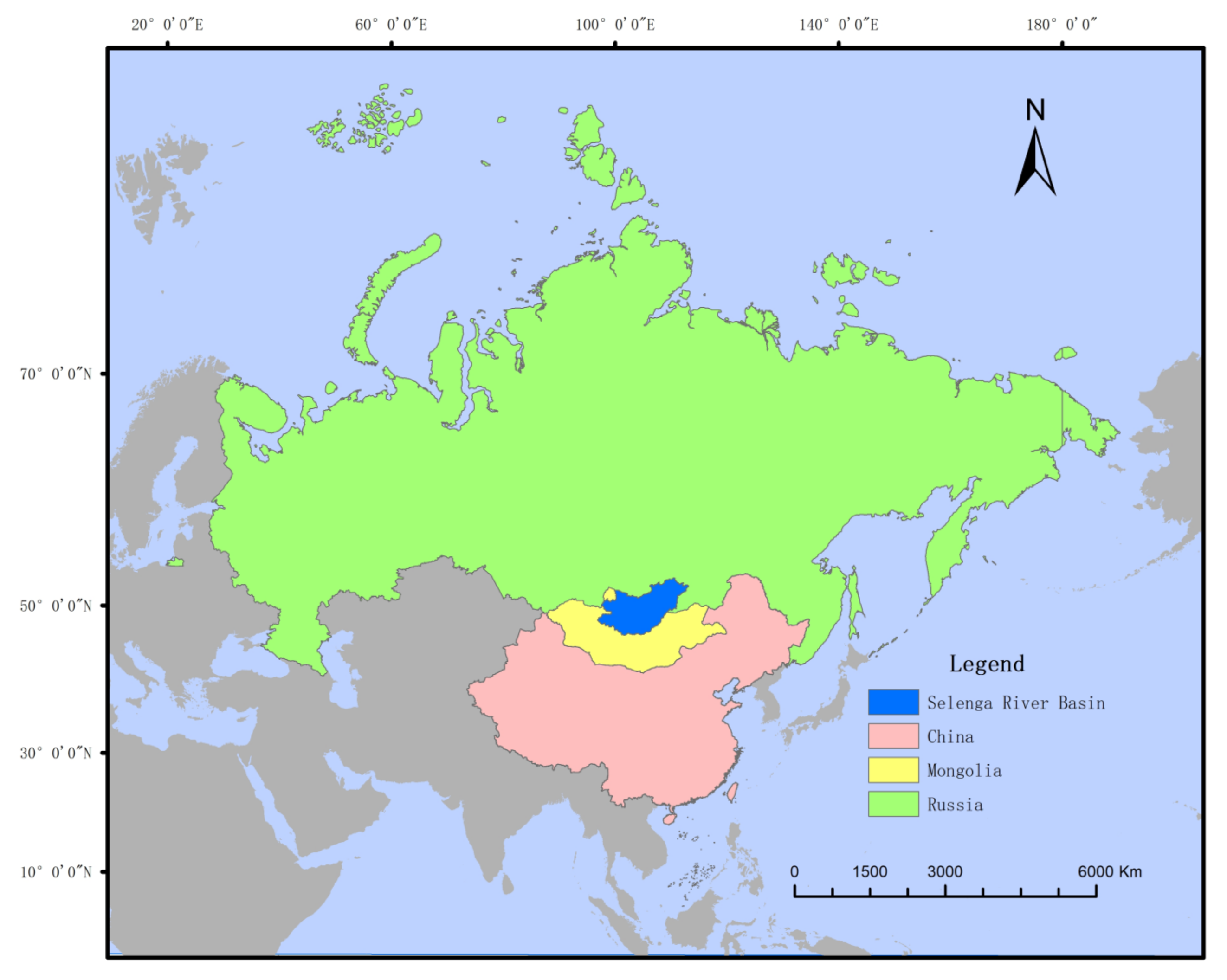








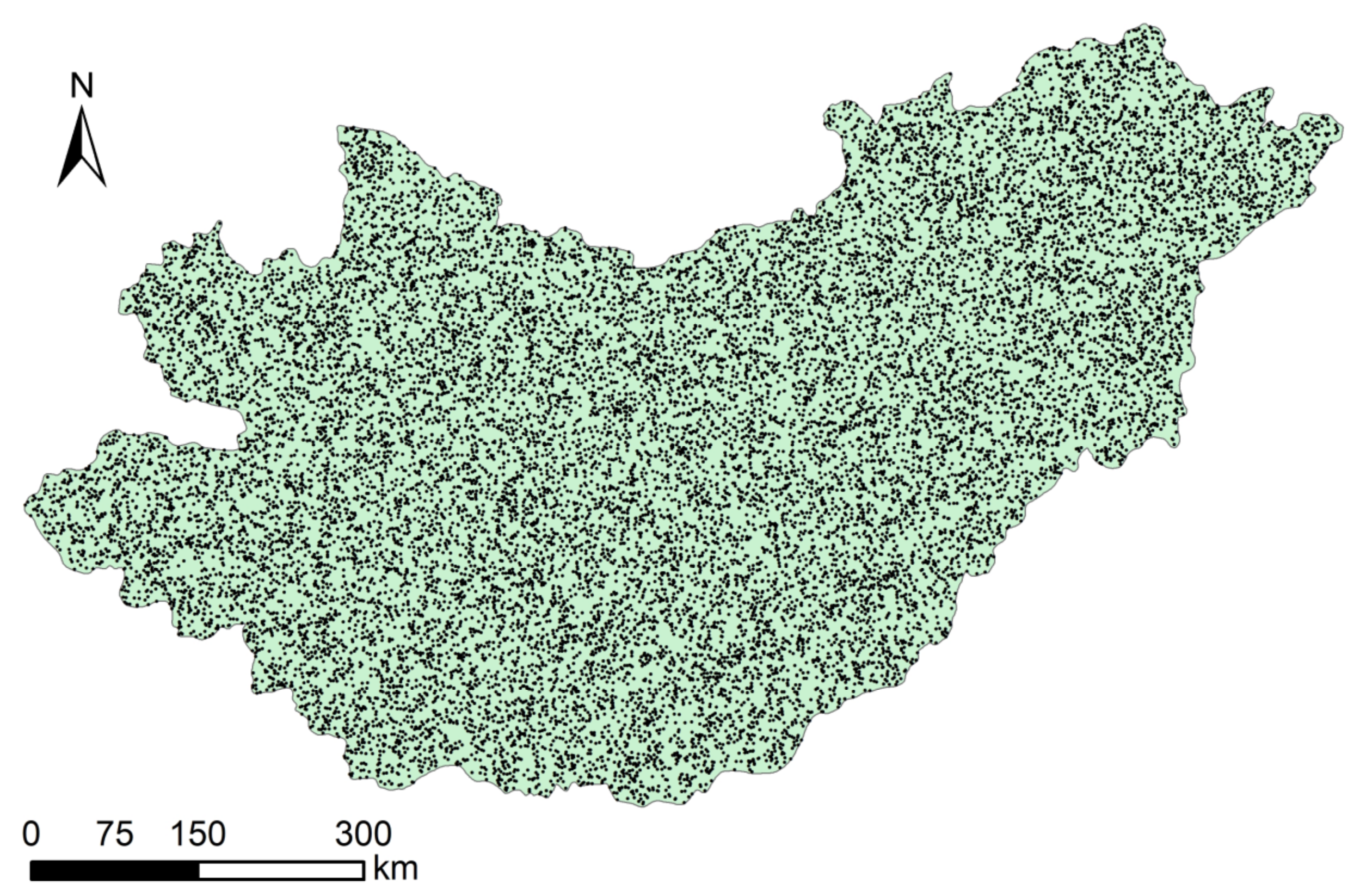
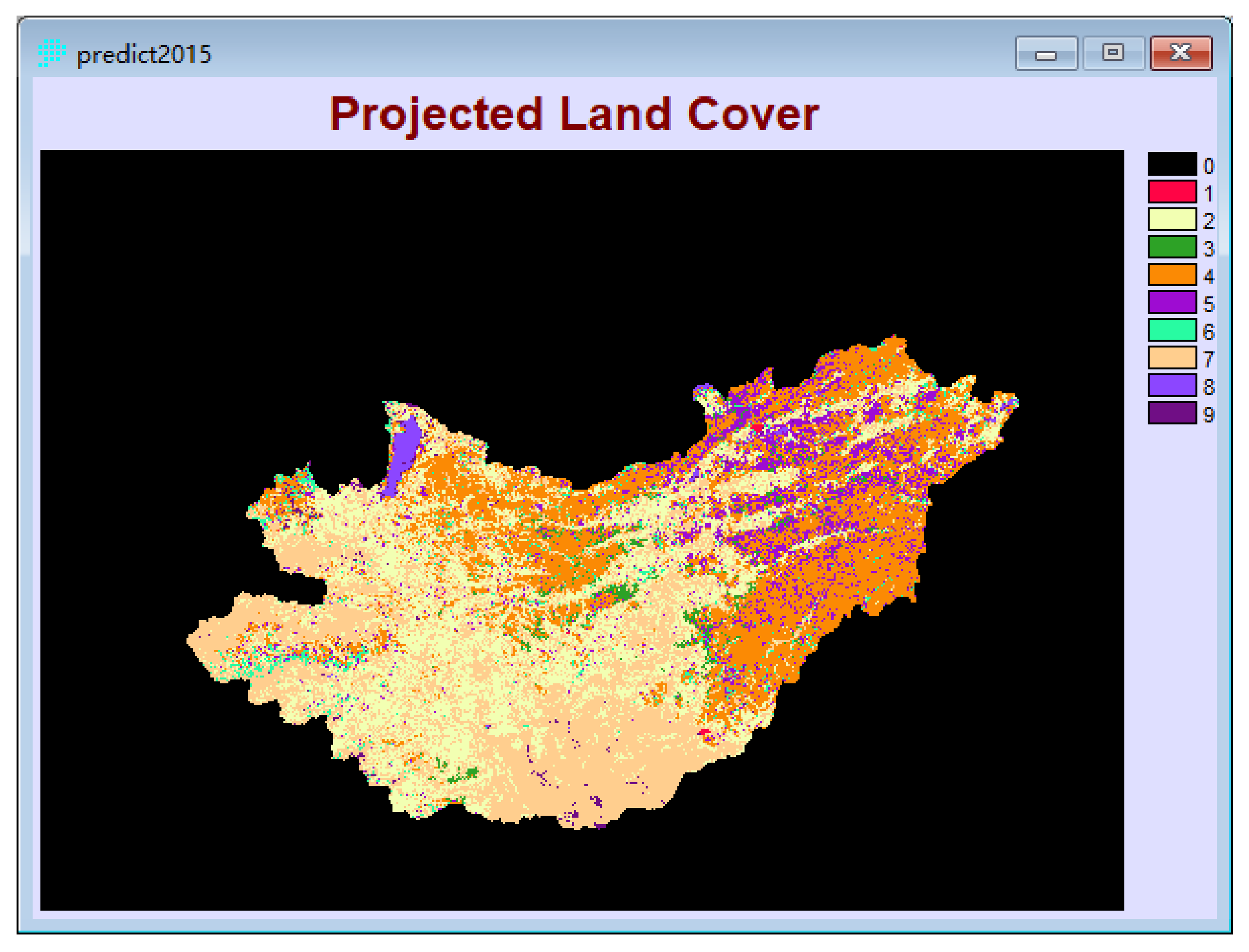
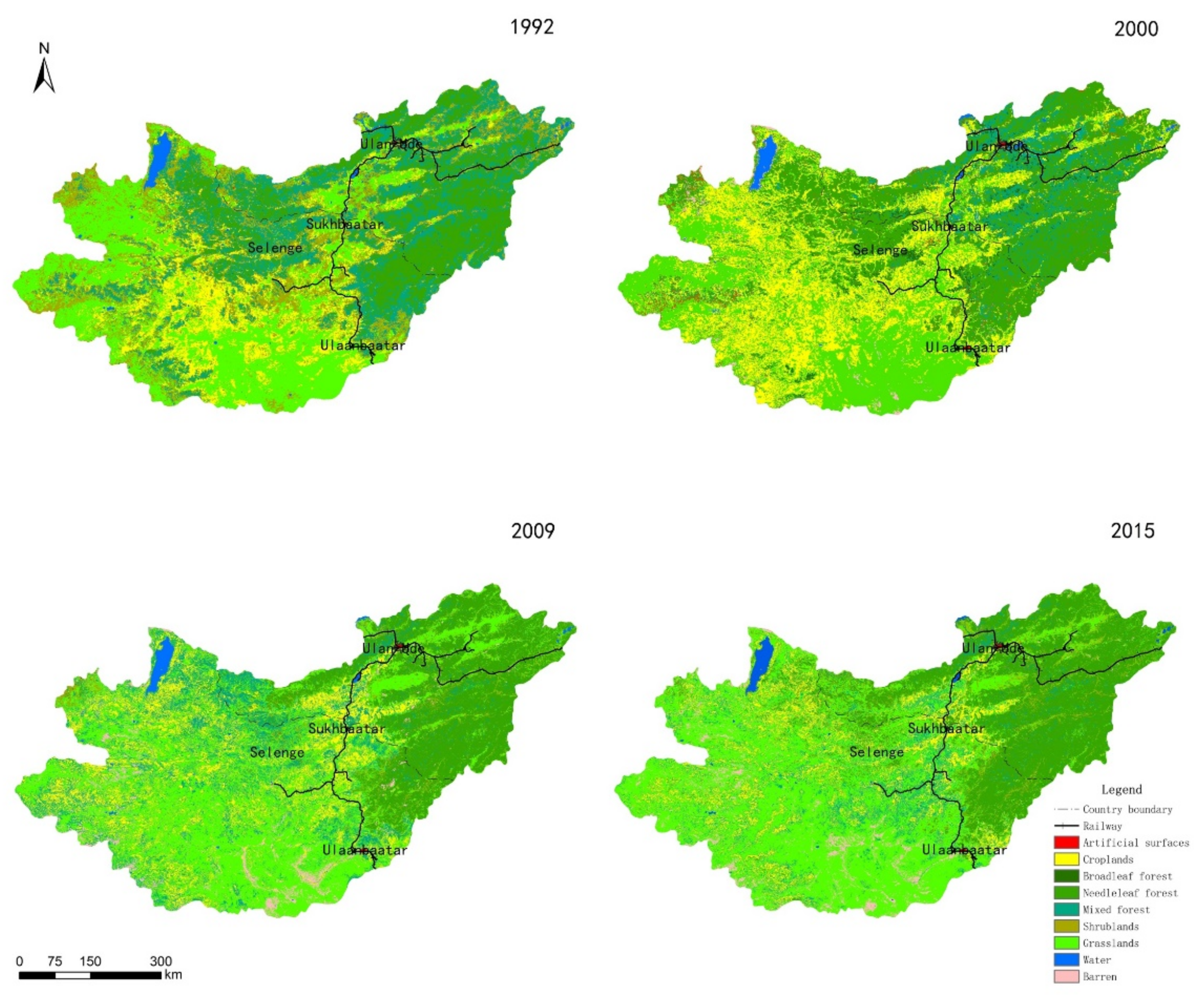
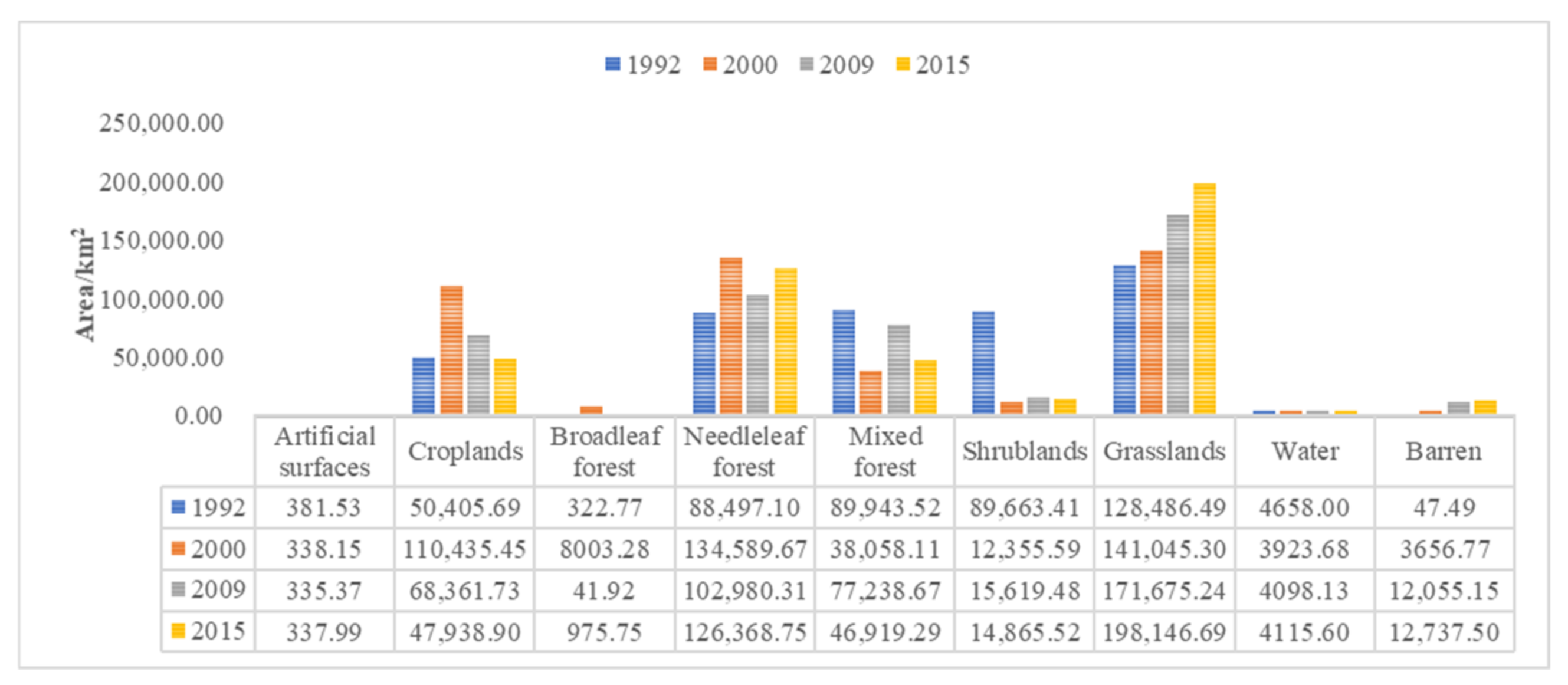
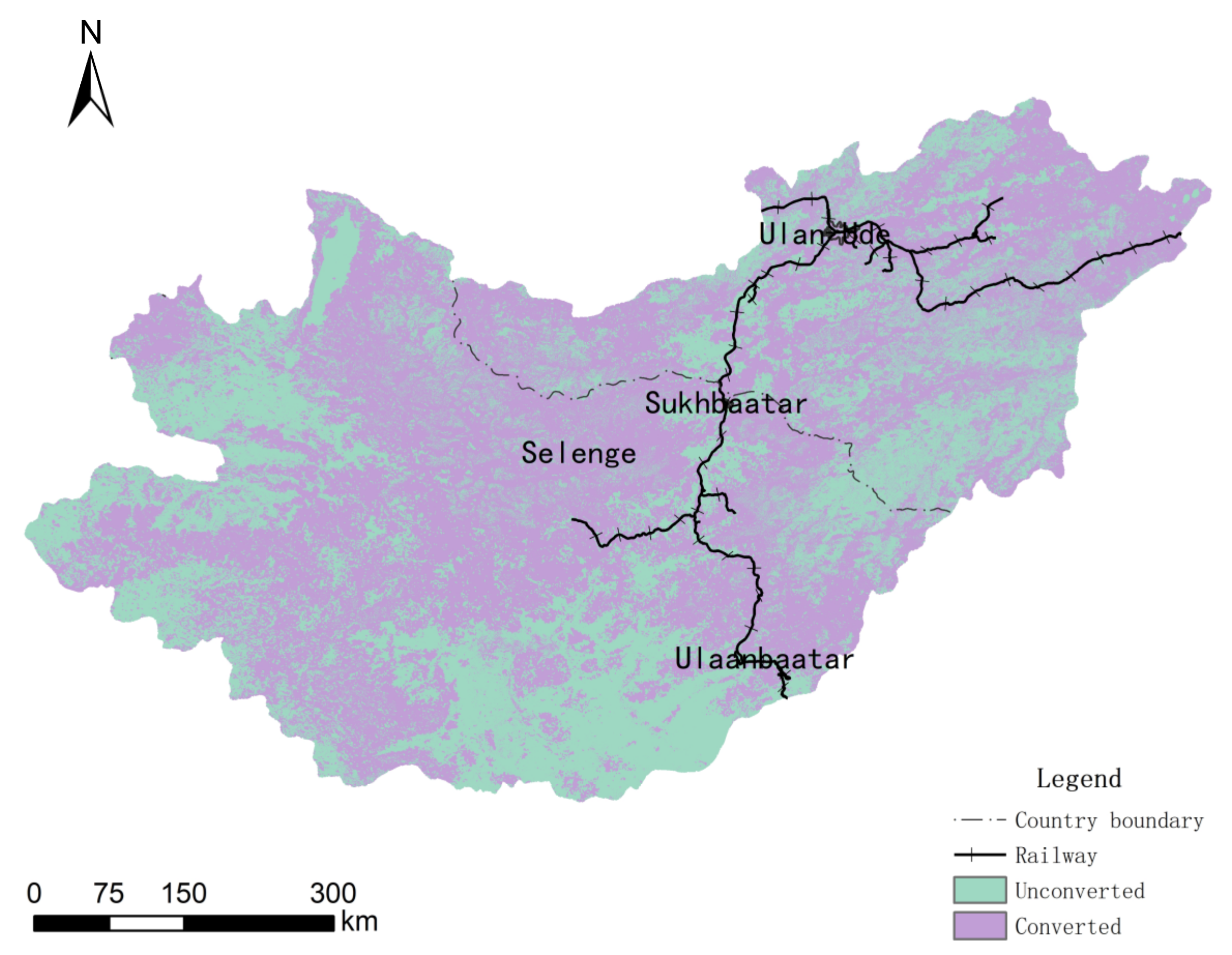

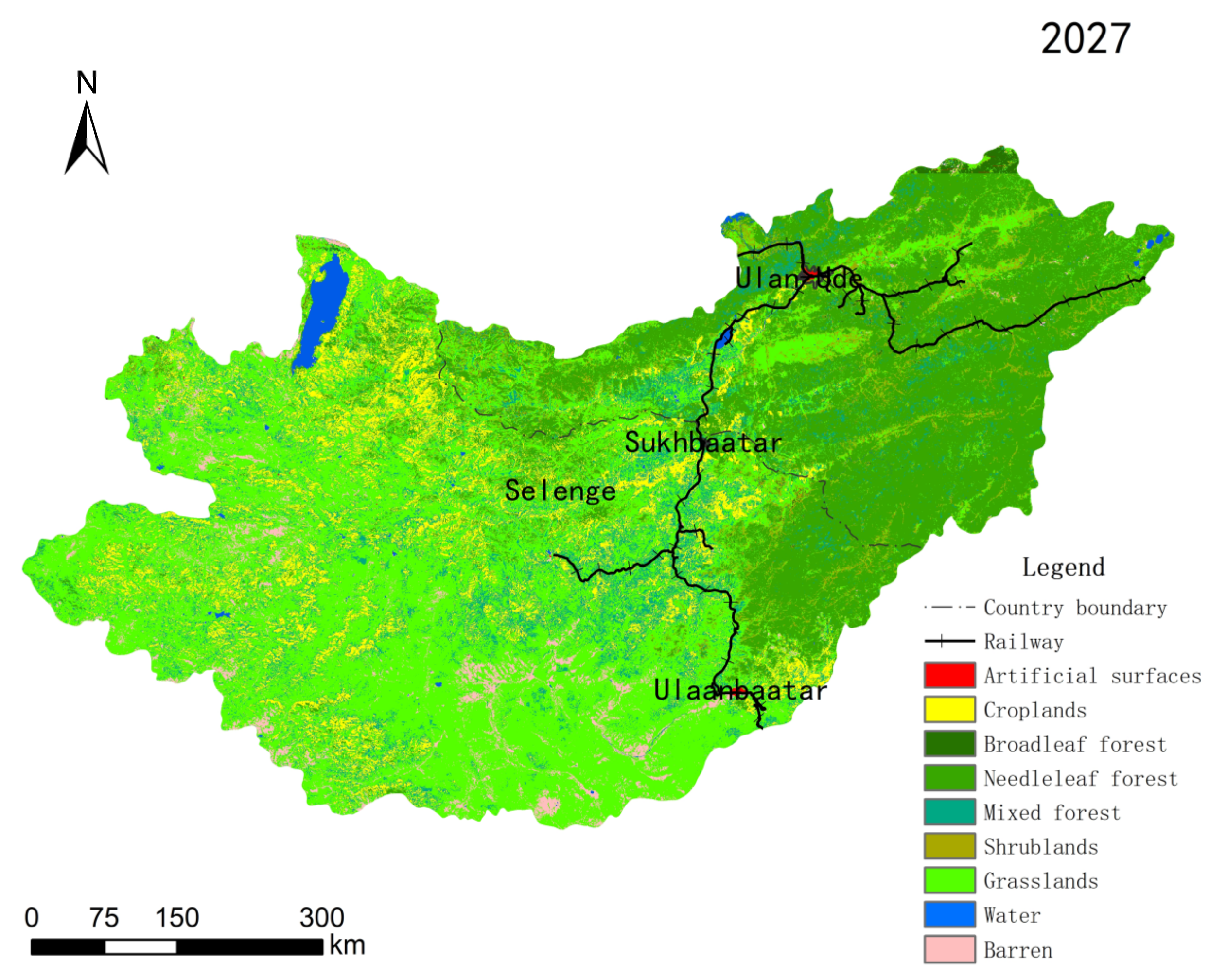
| Class | Description |
|---|---|
| Artificial surfaces | Mainly include urban and rural areas, industrial and mining regions, transportation and other construction lands. |
| Croplands | Land mainly covered by crops that do not require irrigation or seasonal irrigation or crops that require periodic irrigation (mainly rice), including indistinguishable vegetation mosaic types containing farmland. |
| Broadleaf forest | Land covered by evergreen or seasonally deciduous broad-leaved trees. |
| Needleleaf forest | Land covered by evergreen or seasonally deciduous conifers. |
| Mixed forest | Land covered by broad-leaved and conifer trees with a coverage of 25–75% for each species. |
| Shrublands | Woody vegetation, height between 0.3–5 m. |
| Grasslands | Land covered by more than 15% herbaceous plants. |
| Water | Mainly include rivers, lakes, reservoirs, and areas that are periodically submerged by water. |
| Barren | Mainly refers to the surface almost no vegetation cover or vegetation is relatively sparse. |
| This Article Class Code | Umd 1992 Land Cover Data Set | GLCC 2000 | Glob Cover 2009 | FROM-GLC 2015 | ||||
|---|---|---|---|---|---|---|---|---|
| Code | Class | Code | Class | Code | Class | Code | Class | |
| 1 | 11 | Croplands | 17 | Mosaic: Cropland/Tree Cover/Other natural vegetation | 11 | Post-flooding or irrigated croplands (or aquatic) | 11 | Rice paddy |
| 18 | Mosaic: Cropland/Shrub and/or grass cover | 14 | Rainfed croplands | 12 | Greenhouse | |||
| 16 | Cultivated and managed areas | 20 | Mosaic cropland (50–70%)/vegetation (grassland/shrubland/forest) (20–50%) | 13 | Other Cropland | |||
| 14 | Orchard | |||||||
| 15 | Bare farmland | |||||||
| 2 | 14 | Urban and Built-Up | 22 | Artificial surfaces and associated areas | 190 | Artificial surfaces and associated areas (Urban areas > 50%) | 80 | Impervious surface |
| 3 | 2 | Evergreen Broadleaf Forest | 1 | Tree Cover, broadleaved, evergreen | 40 | Closed to open (>15%) broadleaved evergreen or semi-deciduous forest (>5 m) | 21 | Broadleaf, leaf-on |
| 4 | Deciduous Broadleaf Forest | 2 | Tree Cover, broadleaved, deciduous, closed | 50 | Closed (>40%) broadleaved deciduous forest (>5 m) | 22 | Broadleaf, leaf-off | |
| 3 | Tree Cover, broadleaved, deciduous, open | 60 | Open (15–40%) broadleaved deciduous forest/woodland (>5 m) | |||||
| 160 | Closed to open (>15%) broadleaved forest regularly flooded (semi-permanently or temporarily)—Fresh or brackish water | |||||||
| 4 | 1 | Evergreen Needleleaf Forest | 4 | Tree Cover, needle-leaved, evergreen | 70 | Closed (>40%) needleleaved evergreen forest (>5 m) | 23 | Needleleaf, leaf-on |
| 3 | Deciduous Needleleaf Forest | 5 | Tree Cover, needle-leaved, deciduous | 90 | Open (15–40%) needleleaved deciduous or evergreen forest (>5 m) | 24 | Needleleaf, leaf-off | |
| 5 | 5 | Mixed Forest | 6 | Tree Cover, mixed leaf type | 30 | Mosaic vegetation (grassland/shrubland/forest) (50–70%)/cropland (20–50%) | 25 | Mixed leaf, leaf-on |
| 6 | Woodlands | 7 | Tree Cover, regularly flooded, fresh water | 100 | Closed to open (>15%) mixed broadleaved and needleleaved forest (>5 m) | 26 | Mixed leaf, leaf-off | |
| 8 | Tree Cover, regularly flooded, saline water | |||||||
| 9 | Mosaic: Tree Cover/Other natural vegetation | |||||||
| 10 | Tree Cover, burnt | |||||||
| 6 | 7 | Wooded Grasslands/Shrublands | 11 | Shrub Cover, closed-open, evergreen | 110 | Mosaic forest or shrubland (50–70%)/grassland (20–50%) | 41 | Shrubland, leaf-on |
| 8 | Closed Bushlands or Shrublands | 12 | Shrub Cover, closed-open, deciduous | 130 | Closed to open (>15%) (broadleaved or needleleaved, evergreen or deciduous) shrubland (<5 m) | 42 | Shrubland, leaf-off | |
| 9 | Open Shrublands | 15 | Regularly flooded shrub and/or herbaceous cover | 170 | Closed (>40%) broadleaved forest or shrubland permanently flooded—Saline or brackish water | 71 | Shrub and brush tundra | |
| 7 | 10 | Grasslands | 13 | Herbaceous Cover, closed-open | 120 | Mosaic grassland (50–70%)/forest or shrubland (20–50%) | 31 | Pasture |
| 14 | Sparse herbaceous or sparse shrub cover | 140 | Closed to open (>15%) herbaceous vegetation (grassland, savannas or lichens/mosses) | 32 | Natural grassland | |||
| 150 | Sparse (<15%) vegetation | 33 | Grassland, leaf-off | |||||
| 180 | Closed to open (>15%) grassland or woody vegetation on regularly flooded or waterlogged soil—Fresh, brackish or saline water | 72 | Herbaceous tundra | |||||
| 8 | 0 | Water | 20 | Water Bodies | 210 | Water bodies | 51 | Marshland |
| 52 | Mudflat | |||||||
| 53 | Marshland, leaf-off | |||||||
| 60 | Water | |||||||
| 9 | 12 | Barren | 19 | Bare Areas | 200 | Bare areas | 90 | Bareland |
| 21 | Snow and Ice | 220 | Permanent snow and ice | 101 | Snow | |||
| 102 | Ice | |||||||
| Variable | Description | Unit | Source | |
|---|---|---|---|---|
| Topography | Altitude | Elevation | m | DEM |
| Slope | The degree of steepness of the surface unit | ° | DEM | |
| Aspect | The degree of acceptance of sunlight | - | DEM | |
| Neighborhood | The distance to the river | Human turbulence | m | Vector |
| The distance to the road | Human turbulence | m | Vector | |
| The distance to the railway | Human turbulence | m | Vector | |
| Meteorology | Average annual temperature | Multiyear average temperature | ℃ | CRU |
| Annual precipitation | Multiyear precipitation | mm | CRU | |
| Society | Population density | Human activity | people/km2 | NASA |
| Class | Slope | Aspect | The Distance to the Railway | The Distance to the River | The Distance to the Road |
|---|---|---|---|---|---|
| Artificial surfaces | 1–2 | 3–8 | 1 | 1–3 | 1 |
| Croplands | 1–2 | 3–8 | 1–4 | 1–3 | 1–2 |
| Forest | 1–3 | 3–7 | 1–2 | 1–4 | 1–3 |
| Grasslands | 1–3 | 2–8 | 1–5 | 1–3 | 1–2 |
| 1992 | Artificial Surfaces | Croplands | Broadleaf Forest | Needleleaf Forest | Mixed Forest | Shrublands | Grasslands | Water | Barren | |
|---|---|---|---|---|---|---|---|---|---|---|
| 2015 | ||||||||||
| Artificial surfaces | 82.47 | 15.95 | 0.5 | 33.3 | 31.92 | 41.15 | 168.66 | 3.74 | 13.7 | |
| Croplands | 6.68 | 4505.34 | 51.48 | 757.11 | 8711.32 | 881.81 | 37,079.02 | 53.28 | 1020.64 | |
| Broadleaf forest | 0 | 1.32 | 58.86 | 89.21 | 30.52 | 12.63 | 149.91 | 0.67 | 0.26 | |
| Needleleaf forest | 1.25 | 5331.52 | 273.55 | 66662.51 | 4729.21 | 3465.25 | 10,325.64 | 40.01 | 144.16 | |
| Mixed forest | 36.2 | 437.81 | 6649.26 | 46,452.4 | 10,900.39 | 5094.67 | 22,348.02 | 82.02 | 300 | |
| Shrublands | 35.18 | 183.16 | 4120.54 | 16,203.67 | 12,828.81 | 16,871.99 | 39,469.03 | 262.96 | 1821.17 | |
| Grasslands | 180.57 | 9633.53 | 69.11 | 2516.11 | 15,185.46 | 1872.5 | 93,250.9 | 210.01 | 11,261.12 | |
| Water | 10.46 | 113.92 | 4.02 | 348.59 | 74.6 | 98.28 | 395.91 | 3521.66 | 81.6 | |
| Barren | 0 | 0.78 | 0 | 0 | 0.36 | 0.66 | 2.46 | 11.11 | 17.32 | |
Publisher’s Note: MDPI stays neutral with regard to jurisdictional claims in published maps and institutional affiliations. |
© 2022 by the authors. Licensee MDPI, Basel, Switzerland. This article is an open access article distributed under the terms and conditions of the Creative Commons Attribution (CC BY) license (https://creativecommons.org/licenses/by/4.0/).
Share and Cite
Ren, Y.; Li, Z.; Li, J.; Ding, Y.; Miao, X. Analysis of Land Use/Cover Change and Driving Forces in the Selenga River Basin. Sensors 2022, 22, 1041. https://doi.org/10.3390/s22031041
Ren Y, Li Z, Li J, Ding Y, Miao X. Analysis of Land Use/Cover Change and Driving Forces in the Selenga River Basin. Sensors. 2022; 22(3):1041. https://doi.org/10.3390/s22031041
Chicago/Turabian StyleRen, Yang, Zehong Li, Jingnan Li, Yan Ding, and Xinran Miao. 2022. "Analysis of Land Use/Cover Change and Driving Forces in the Selenga River Basin" Sensors 22, no. 3: 1041. https://doi.org/10.3390/s22031041
APA StyleRen, Y., Li, Z., Li, J., Ding, Y., & Miao, X. (2022). Analysis of Land Use/Cover Change and Driving Forces in the Selenga River Basin. Sensors, 22(3), 1041. https://doi.org/10.3390/s22031041








